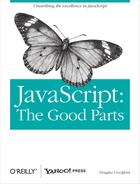JavaScript provides an exception handling mechanism. Exceptions are unusual (but not completely unexpected) mishaps that interfere with the normal flow of a program. When such a mishap is detected, your program should throw an exception:
var add = function (a, b) {
if (typeof a !== 'number' || typeof b !== 'number') {
throw {
name: 'TypeError',
message: 'add needs numbers'
};
}
return a + b;
}The throw statement interrupts execution of the
function. It should be given an exception object
containing a name property that identifies the
type of the exception, and a descriptive message
property. You can also add other properties.
The exception object will be delivered to the
catch clause of a try statement:
// Make a try_it function that calls the new add
// function incorrectly.
var try_it = function ( ) {
try {
add("seven");
} catch (e) {
document.writeln(e.name + ': ' + e.message);
}
}
try_it( );If an exception is thrown within a try block,
control will go to its catch clause.
A try statement has a single catch block that will catch all exceptions. If your
handling depends on the type of the exception, then the exception handler will have
to inspect the name to determine the type of the
exception.
